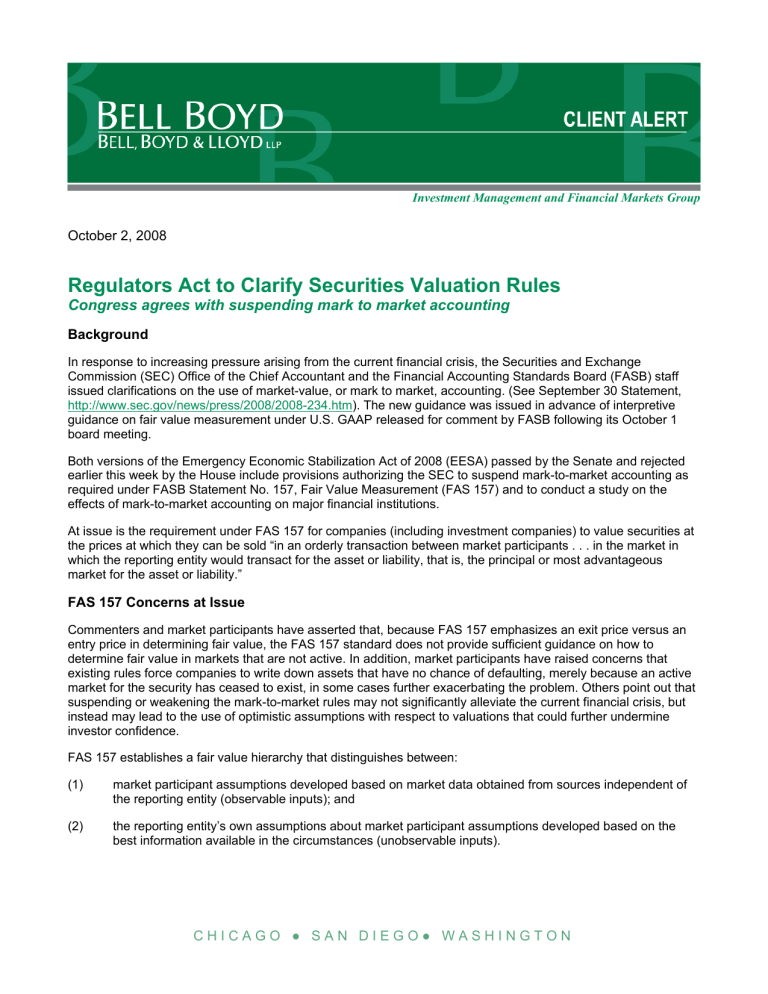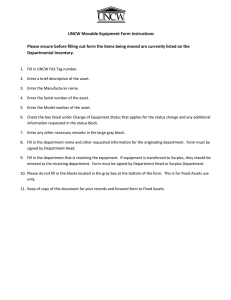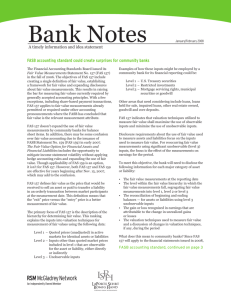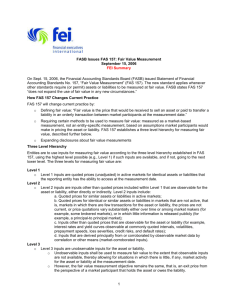Regulators Act to Clarify Securities Valuation Rules October 2, 2008

Investment Management and Financial Markets Group
October 2, 2008
Regulators Act to Clarify Securities Valuation Rules
Congress agrees with suspending mark to market accounting
Background
In response to increasing pressure arising from the current financial crisis, the Securities and Exchange
Commission (SEC) Office of the Chief Accountant and the Financial Accounting Standards Board (FASB) staff issued clarifications on the use of market-value, or mark to market, accounting. (See September 30 Statement, http://www.sec.gov/news/press/2008/2008-234.htm
). The new guidance was issued in advance of interpretive guidance on fair value measurement under U.S. GAAP released for comment by FASB following its October 1 board meeting.
Both versions of the Emergency Economic Stabilization Act of 2008 (EESA) passed by the Senate and rejected earlier this week by the House include provisions authorizing the SEC to suspend mark-to-market accounting as required under FASB Statement No. 157, Fair Value Measurement (FAS 157) and to conduct a study on the effects of mark-to-market accounting on major financial institutions.
At issue is the requirement under FAS 157 for companies (including investment companies) to value securities at the prices at which they can be sold “in an orderly transaction between market participants . . . in the market in which the reporting entity would transact for the asset or liability, that is, the principal or most advantageous market for the asset or liability.”
FAS 157 Concerns at Issue
Commenters and market participants have asserted that, because FAS 157 emphasizes an exit price versus an entry price in determining fair value, the FAS 157 standard does not provide sufficient guidance on how to determine fair value in markets that are not active. In addition, market participants have raised concerns that existing rules force companies to write down assets that have no chance of defaulting, merely because an active market for the security has ceased to exist, in some cases further exacerbating the problem. Others point out that suspending or weakening the mark-to-market rules may not significantly alleviate the current financial crisis, but instead may lead to the use of optimistic assumptions with respect to valuations that could further undermine investor confidence.
FAS 157 establishes a fair value hierarchy that distinguishes between:
(1) market participant assumptions developed based on market data obtained from sources independent of the reporting entity (observable inputs); and
(2) the reporting entity’s own assumptions about market participant assumptions developed based on the best information available in the circumstances (unobservable inputs).
C H I C A G O ● S A N D I E G O ● W A S H I N G T O N
The use of unobservable inputs is intended to allow for situations in which there is little, if any, market activity for the asset at the measurement date. Within this value hierarchy there are three levels:
Level 1 valuations are based on an asset’s actual market price;
Level 2 valuations are performed when there are no quoted prices available, and are derived from observable inputs;
Level 3 valuations are based on unobservable inputs.
September 30 Statement – Key Elements
The September 30 Statement provides greater latitude for companies to use proprietary financial models and their own judgment if no market exists, or if the market currently reflects only forced liquidation pricing. The key elements of the September 30 Statement are as follows:
• When an active market for a security does not exist, the use of management estimates that incorporate current market participant expectations of future cash flows, and include appropriate risk premiums, is acceptable.
• When significant adjustments to available observable inputs are required, a company may be justified in using an estimate based primarily on unobservable inputs.
•
•
•
•
Broker quotes are not necessarily determinative if an active market does not exist for the security. In weighing a broker quote as an input to fair value, an entity should place less reliance on quotes that do not reflect the result of market transactions and should consider whether the quote is an indicative price or a binding offer.
Distressed or forced liquidation sales are not orderly transactions, and thus are not determinative when measuring fair value.
A quoted market price in an active market for the identical asset is most representative of fair value and thus is required to be used (generally without adjustment). Prices in an inactive market that do not reflect current prices for the same or similar assets, however, may require adjustment to arrive at fair value.
A significant increase in the spread between the amount sellers are "asking" and the price that buyers are
"bidding," or the presence of a relatively small number of "bidding" parties, are indicators that should be considered in determining whether a market is inactive.
•
•
•
The September 30 Statement also discusses the factors that should be considered in determining whether an investment is other-than-temporarily impaired. In general, the statement provides that the greater the decline in value, the greater the period of time until anticipated recovery, and the longer the period of time that a decline has existed, the greater the level of evidence necessary to reach a conclusion that an other-than-temporary decline has not occurred.
The September 30 Statement notes that existing U.S. GAAP does not provide "bright lines" or "safe harbors" in making a judgment about other-than-temporary impairments. Citing SAB Topic 5M1, the statement sets out the following factors to consider:
The length of the time and the extent to which the market value has been less-than cost;
The financial condition and near-term prospects of the issuer; or
The intent and ability of the holder to retain its investment in the issuer for a period of time sufficient to allow for any anticipated recovery in market value.
Although the September 30 Statement does allow more latitude to management, fair value evaluation continues to be based upon the exit price. In addition, in circumstances in which market quotations are not “readily
2
available,” open- and closed-end funds must continue to fair value assets in accordance with the SEC’s view that the fair value of a security is the price which the fund might reasonably expect to receive upon its current sale.
Though funds may take into account the valuation guidance set out in the bullet points above, the valuation standard for open- and closed-end funds should continue to be based upon what the fund could reasonably expect to receive for its assets if disposed of over a seven-day period.
Proposed FASB Staff Position No. FAS 157-d:
Determining Fair Value in a Market That Is Not Active
FASB considered a FASB Staff Position (FSP) regarding additional guidance on FAS 157 covering fair value accounting for assets when markets have become inactive. The proposed FSP is intended to clarify FAS 157 in an inactive market and provides an illustrative example of how to determine fair value of a financial asset when the market for the asset is not active. The Exposure Draft presented to the Board stated that the example would emphasize the following points:
•
•
•
Observable inputs may require such significant adjustment as to render them unobservable or Level 3 inputs. In such a case, the entity might then conclude that an income approach valuation technique that uses management’s internal assumptions about expectations of cash flow is equally or more representative of fair value. The valuation must still include appropriate adjustments for risks such as nonperformance and liquidity.
Even where there is limited or no market activity for an asset, the fair value measurement objective remains the exit price from the perspective of a market participant.
Broker quotes or pricing services may be a relevant input, but entities should place less reliance on quotes that do not reflect the result of market transactions.
The Board approved an accelerated comment period ending October 9, 2008. A second Board meeting will be held on October 10 to discuss comments received and any related matters.
House and Senate Bill Provisions Permit Suspending Mark-to-Market Accounting
The two versions of The Emergency Economic Stabilization Act of 2008, passed by the Senate on Wednesday,
October 1 and voted down on Monday, September 29 by the House, contained identical provisions permitting suspension of mark to market accounting under FAS 157 and directing the SEC to conduct a study on the affects of the mark-to-market rules on major financial institutions within 90 days of becoming law. The revised House bill, to be reconsidered later this week, also contains that same provision.
For further information or an update on proposed revisions to the SEC valuation rules, contact, Molly Moynihan
(202-955-7027, mmoynihan@bellboyd.com), of Bell Boyd’s Investment Management and Financial Markets
Group.
For further information, please contact Cheryl Allaire 858-509-7424, Cameron Avery 312-807-4302,
Kevin Bettsteller 312-807-4442, Paul Dykstra 312-781-6029, David Glatz 312-807-4295, Alan Goldberg 312-807-4227,
Mark Greer 312-807-4393, Elizabeth Hudson 312-807-4376, Stevens Kelly 312-807-4240, Molly Moynihan 202-955-7027,
Anna Paglia 312-781-7163, Joanne Phillips 202-955-6824, Paulita Pike 312-781-6027, Eric Purple 202-955-7081,
Bruce Rosenblum 202-955-7087, Donald Weiss 312-807-4303, Gwendolyn Williamson 202-955-7059, or
Stacy Winick 202-955-7040 of Bell, Boyd & Lloyd’s Investment Management and Financial Markets Group or visit our Web site at www.bellboyd.com.
This publication has been prepared by the Investment Management and Financial Markets Group of Bell, Boyd & Lloyd LLP for clients and friends of the firm and is for information only. It is not a substitute for legal advice or individual analysis of a particular legal matter. Readers should not act without seeking professional legal counsel. Transmission and receipt of this publication does not create an attorney-client relationship.
© 2008 Bell, Boyd & Lloyd LLP All Rights Reserved www.bellboyd.com





